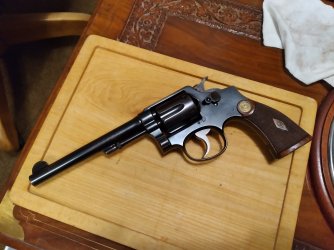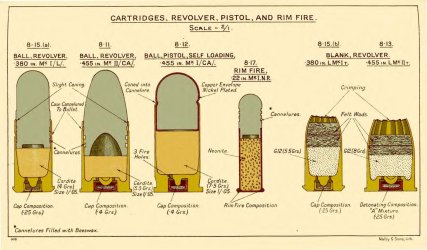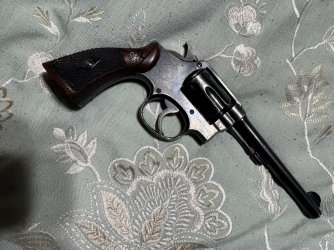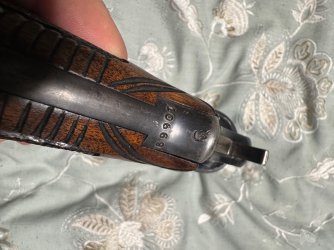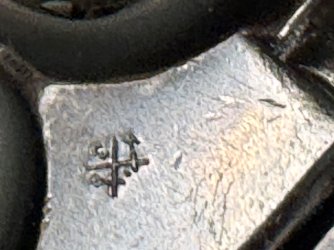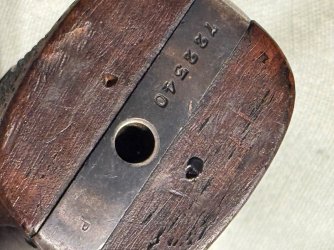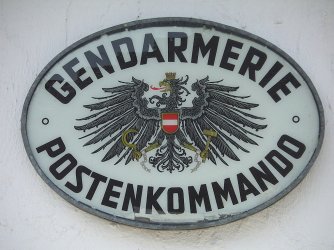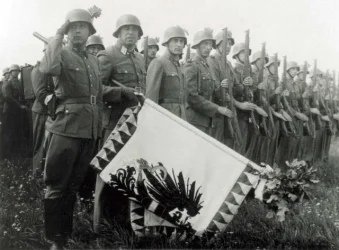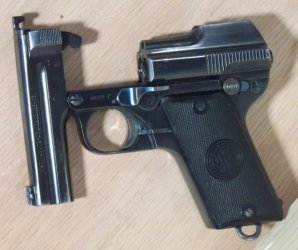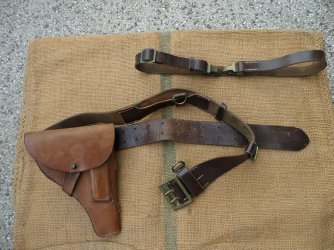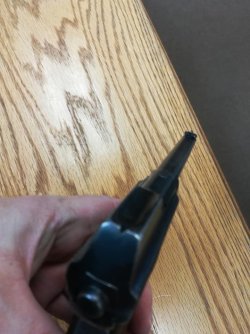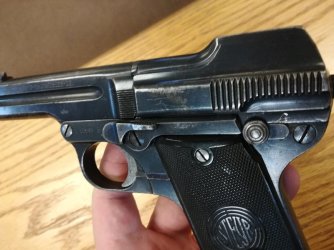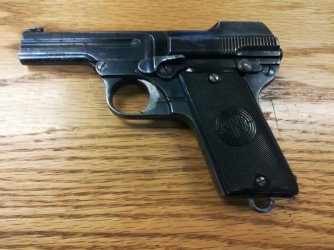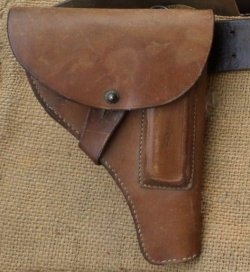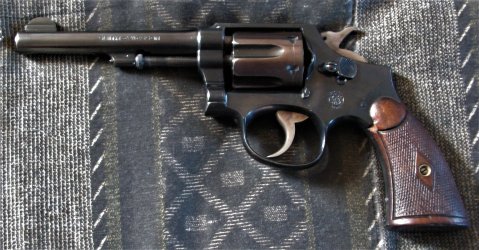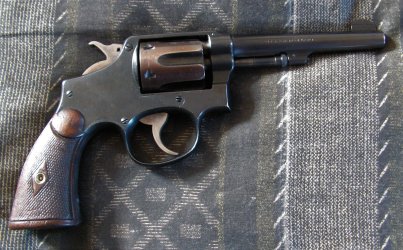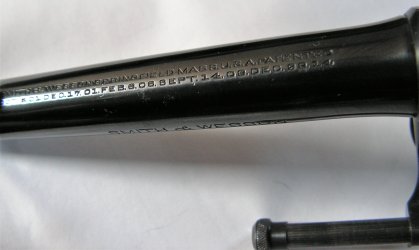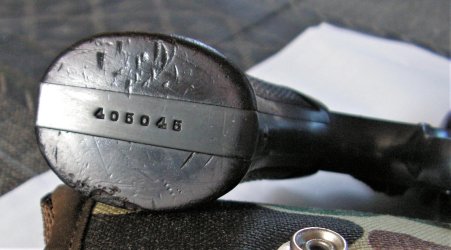The 38 S&W cartridge has a slightly larger diameter than the 38 Special. A 38 S&W will not normally chamber in a 38 Special cylinder.
You are using an out of date browser. It may not display this or other websites correctly.
You should upgrade or use an alternative browser.
You should upgrade or use an alternative browser.
38 M&P Model 1905, 4th change. With unusual markings
- Thread starter Long Branch Setter
- Start date
If a live round was head stamped 38 THIS gun would probably fire it and save your life.
Nice gun to have during the time period.
Nice gun to have during the time period.
38MkIIz vas the cartridge designed from Col. Boys for Enfield N°2 pistol in 1930 and is a "dragster" S&W 38 with 200 gr ball and heavy load of "neonite", In I WW British service used ,455 pistols like Webley Mk VI, Colt 1909 and S&W triple lock,380 MK II sounds British to me. Is the gun .38 S&W or is it .38 S&W Special?
I'm thinking if .38 S&W you may have a British Service Revolver. A lot of those guns wound up in police service in Europe after WWII. The other mark might be German or Austrian. Something to do with where it was used after the war. If the serial number is 439216 I am probably wrong.
Enfield N°2 is pierced at .360" but Webley and S&W maintains .358.
Late S&W 10 for US NAVY where chambered fo '39 S&W Special ctg but are really fragile guns and often broks barrel
Postwar many european armourer modify cilinder to accomodate 38 Special cartridge, often without termal treatment. Tehe are expecially dangerous weapons.
Attachments
DWalt
Member
Prior to Lend Lease and the U.S. entry into the war, the British purchasing commission was buying up whatever guns they could find in the USA including dealer stock for their war effort. Simple enough to ream the chambers of .38 Special revolvers to accept the .380 military cartridge and put them into military service. Yours could very well have been one of those which was given to the Austrian civil police by the British during the postwar occupation period.
Last edited:
Yes, you are mistaken . . . .I'm going to do some research but thought the 38 S&W was just a shorter version of the 38 S&W Special. Am I mistaken? . . . . .
The 38 Smith&Wesson cartridge is slightly FATTER than the 38 Special. (As is the groove diameter also.)
RM Vivas
US Veteran
This could be one of those "send a gun to defend a British home" sort of deals that wound up in British military hands and at the end of the war went to arm the Occupation police. Just a thought.
Best,
RM Vivas
Best,
RM Vivas
Rakkasan13F
Member
It sounds like this gun might be worth lettering, if only to find out where it originally went.
DBrainard
Member
I'm super jealous! This was used by the occupying forces post WW2 then passed on to Austria.
The Brits had 38 Special Pre-Victory revolvers that they ordered direct prior to our involvement in WW2. These WILL NOT be marked U.S. Property and WILL NOT have the V prefix. After the 38/200 Victory models arrived these 38 Specials were handed off to less embattled regions of the Empire. The barrel should read "38 S&W Special CTG"
These are noted in The Smith & Wesson Catalogue under 1905 4th change. (4th edition p163) Yours fits the SN range. I also confirmed the British purchase through Ian Skinnerton, author of "The Broad Arrow." He is a British firearms historian and a good friend.
I collect guns of the British Empire. You have a beautiful revolver! I wish I had one!
Here's some pics of my South African.
The Brits had 38 Special Pre-Victory revolvers that they ordered direct prior to our involvement in WW2. These WILL NOT be marked U.S. Property and WILL NOT have the V prefix. After the 38/200 Victory models arrived these 38 Specials were handed off to less embattled regions of the Empire. The barrel should read "38 S&W Special CTG"
These are noted in The Smith & Wesson Catalogue under 1905 4th change. (4th edition p163) Yours fits the SN range. I also confirmed the British purchase through Ian Skinnerton, author of "The Broad Arrow." He is a British firearms historian and a good friend.
I collect guns of the British Empire. You have a beautiful revolver! I wish I had one!
Here's some pics of my South African.
Attachments
Major 2
Member
What I believe you have... After WWII Austria was divided into 4 sectors.
Under British, French, Russian and US authority.
The British & US rather quickly realized the Austrian Gendarmerie which had been disarmed, needed re-arming.
Under Denazification, the Allied initiative to re-install former Police.
The British supplied 303 Enfield's and revolvers such as yours.
Note: the issue MK #3* Enfields
Under British, French, Russian and US authority.
The British & US rather quickly realized the Austrian Gendarmerie which had been disarmed, needed re-arming.
Under Denazification, the Allied initiative to re-install former Police.
The British supplied 303 Enfield's and revolvers such as yours.
Note: the issue MK #3* Enfields
Austrian Gendarmerie in the British Occupied Sector, early 1950s. Note: the issue MK #3* Enfields
Attachments
Last edited:
.380 MkII was the designation of the FMJ round of the issue ammo until late in 1944 or early '45.
The designation of that FMJ round was changed to .380 MkIIz & sometimes headstamped as .380 2z at that time.
The Austrian Police mark looks like that applied to the mountain of M&P revolvers issued/given post-WW2 to them for Police and Security work.
The designation of that FMJ round was changed to .380 MkIIz & sometimes headstamped as .380 2z at that time.
The Austrian Police mark looks like that applied to the mountain of M&P revolvers issued/given post-WW2 to them for Police and Security work.
What you have is a bargain at $125, and a $1,000 mystery, money well spent, regardless of what you do with it. I do not normally refinish old guns in that shape, however, I probably would that one. And I would shoot it all day long with 38 Special standard pressure loads.
The barrel is marked 38 S&W Special.CTG as you described. It's also not marked US Property.I'm super jealous! This was used by the occupying forces post WW2 then passed on to Austria.
The Brits had 38 Special Pre-Victory revolvers that they ordered direct prior to our involvement in WW2. These WILL NOT be marked U.S. Property and WILL NOT have the V prefix. After the 38/200 Victory models arrived these 38 Specials were handed off to less embattled regions of the Empire. The barrel should read "38 S&W Special CTG"
These are noted in The Smith & Wesson Catalogue under 1905 4th change. (4th edition p163) Yours fits the SN range. I also confirmed the British purchase through Ian Skinnerton, author of "The Broad Arrow." He is a British firearms historian and a good friend.
I collect guns of the British Empire. You have a beautiful revolver! I wish I had one!
Here's some pics of my South African.
Mechanically, the gun is like new.. cosmetically the gun had some pretty bad rust areas on it but no pitting. I may have screwed up by cleaning up the rust but something had to be done or pitting was just around the corner.
Being a history buff at heart, these old guns fascinate me and I wish they could talk.
Since I only paid 125.00 for it I'm going to send off for a letter just because I want to know.
Thank you for your information, it's much appreciated.
Boy - glad the serial number is now known by everyone!!!!! The 38 S&W was a shorter and larger round than the 38 Special. The 38 S&W bullet was .361" dia, and the 38 Special used a .357" bullet. The brass is also larger than a 38 Special and using a original factory 38 Special cylinder, you should not be able to fully chamber a 38 S&W.
I imagine this gun will letter rather prosaically. Its subsequent history, that is, just when and how it came to be altered to accept the British .38 cartridge and the exact circumstances under which it ended up in service with the post-WWII Austrian police are probably undiscoverable.
littlerocknroller
Member
I picked up what I believe to be a Model 1905 38 M&P , 4th change. Ser # 439XXX. Gun was not in good shape outside and I paid 125.00, figured it would be a project this winter for a truck gun.
Started to get the rust off and noticed two stamps I can't find any information on. I appreciate any info people may be able to provide.
I appreciate being here as I love the old S&W revolvers.
View attachment 779287View attachment 779288View attachment 779289
Of you find the markings CB on the gun it does mean that the German gunsmitj Carl Bernhard has converted the gun to . 38 Special. This usually happened to guns having the .38 S&W Calibra with the shorter case. The .38 S&W is a Little thicker which expandiert the 38 Special cases so that they are a little more resistent when reloading during the sizing process. This All might not be relevant to your gun, but maybe you find one some day. For the rest it is correct that the allied forces gave the revolvers to the German or Austrian police after WW II. Excellent information can be found in The fine book of Charles Pate " Handguns of WW II. Enjoy collecting these oldies!I picked up what I believe to be a Model 1905 38 M&P , 4th change. Ser # 439XXX. Gun was not in good shape outside and I paid 125.00, figured it would be a project this winter for a truck gun.
Started to get the rust off and noticed two stamps I can't find any information on. I appreciate any info people may be able to provide.
I appreciate being here as I love the old S&W revolvers.
View attachment 779287View attachment 779288View attachment 779289
Rainer
DWalt
Member
Unfortunately, it is extremely unlikely that a letter will provide even the slightest clue regarding how the revolver found its way into Austrian police service or how it returned to the USA.It sounds like this gun might be worth lettering, if only to find out where it originally went.
I feel the same about refinishing but made an exception for this one. Honest wear and patina is great but rust has to go when it's like this one was.What you have is a bargain at $125, and a $1,000 mystery, money well spent, regardless of what you do with it. I do not normally refinish old guns in that shape, however, I probably would that one. And I would shoot it all day long with 38 Special standard pressure loads.
Major 2
Member
As a relevant but side story, I have a surrendered Austrian Gendarmerie 08/34
Steyr, GI bring back.
The capture papers states May 21, 1945, in Fugging*, formerly spelt (not for decent folk speak with gg replacing ck) until 2021, is an Austrian village in the municipality of Tarsdorf, located North of Salzburg, in the Innviertel region of western Upper Austria.
* Look it up
Steyr, GI bring back.
The capture papers states May 21, 1945, in Fugging*, formerly spelt (not for decent folk speak with gg replacing ck) until 2021, is an Austrian village in the municipality of Tarsdorf, located North of Salzburg, in the Innviertel region of western Upper Austria.
* Look it up
Attachments
Last edited:
You sir have inspired me. Now I have to dig thru my safe and check out one of mine. I was gifted it by a family member decades ago. When I got it, I was surprised because it was loaded, with 38 Special, 38 Long Colt and I think, 38 S and W, all three in the gun. Now, I have to check and see about that second ring inside, for the 38 SW round. It possibly could have been 38 Short Colt for that third set, not sure. I just recall it being loaded with 3 different rounds and quite a mystery for me at the time. The owner was 93 years old and carried it around with him and about $50,000 in cash because he did not trust banks. He was a bit, unique.The barrel is marked 38 S&W Special.CTG as you described. It's also not marked US Property.
Mechanically, the gun is like new.. cosmetically the gun had some pretty bad rust areas on it but no pitting. I may have screwed up by cleaning up the rust but something had to be done or pitting was just around the corner.
Being a history buff at heart, these old guns fascinate me and I wish they could talk.
Since I only paid 125.00 for it I'm going to send off for a letter just because I want to know.
Thank you for your information, it's much appreciated.
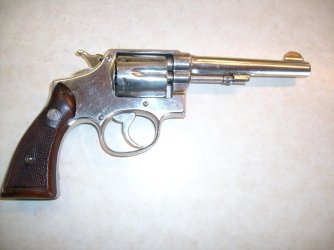
I do reload 38 Short Colt just because they tell the grand daughter they are low recoil ammo for her 38 Special handgun.
This gun has the same early markings and had been back to SW to be nickel plated at some point in time, as evidenced by the "R" stamp on the gun. The last patent on this one was 1917 and we think it was produced shortly after that, making it well over 100 years in the field, some field, somewhere. Like you, the history is worth as much as the gun. Give us some follow up when you get the letter.
As to the rust, absolutely, gotta stop that. I am a big fan of Flex Hones and similar 800 grit size abrasives which can often kill the rust and get down to a level that can be blended to where it does not show. And then protective stuff can protect the finish. I like Ren wax but any will do.
I just find yours fascinating. Who knows what holster that one rode in and what stories it could tell. I have carried issue guns on foreign soil that have their own story. Unfortunately, the government gives and takes away, so those stories are long gone. Sometimes guns are like favorite dogs, they become companions. Am I nuts? Prolly so. Most, like Glocks do not matter, you lose one, buy another tomorrow, they have no personality.....Anyway, thanks for the interesting post.
Information from Cartridges of the World. .38 Long Colt can be fired in a .38 Special. Assume .38 Short Colt could be also. Both of the Colt cartridges were shorter versions of the .38 Special. .38 Special was also called .38 Colt Special. Just like S&W did not like to use the Colt or Winchester name on their guns, Colt did not want to give any credit to S&W.
.38 S&W is also known as .38 Colt New Police and with a 200 grain bullet as .38 Super Police. The British service load is called .380/200. Also referred to as .380/200 MK I. .380 MK II like your gun is marked was a 180 grain FMJ bullet.
Many .38 S&W guns were converted to .38 Special. Because the .38 S&W chambers are larger diameter have heard of .38 Special cases swelling or splitting. Think most folks think safe to use.
Your gun is the opposite. .38 Special converted to .38 S&W. Same situation if you use .38 Special ammo.
.38 S&W is also known as .38 Colt New Police and with a 200 grain bullet as .38 Super Police. The British service load is called .380/200. Also referred to as .380/200 MK I. .380 MK II like your gun is marked was a 180 grain FMJ bullet.
Many .38 S&W guns were converted to .38 Special. Because the .38 S&W chambers are larger diameter have heard of .38 Special cases swelling or splitting. Think most folks think safe to use.
Your gun is the opposite. .38 Special converted to .38 S&W. Same situation if you use .38 Special ammo.
Last edited:
DWalt
Member
The significance of Mark 2z or Mark IIz is that the z denotes the use of nitrocellulose granular powder propellant, sort of like Bullseye, etc. Lack of the z indicates Cordite was used. The cartridge is the same, only the propellant type is different. There were numerous types and varieties of Cordite used in British ammunition through WWII. I never understood why the British were so married to Cordite instead of using nitrocellulose granular powders like the rest of the world..380 MkII was the designation of the FMJ round of the issue ammo until late in 1944 or early '45.
The designation of that FMJ round was changed to .380 MkIIz & sometimes headstamped as .380 2z at that time.
The Austrian Police mark looks like that applied to the mountain of M&P revolvers issued/given post-WW2 to them for Police and Security work.
Last edited:
That looks pretty good for a refinish. Nice work.This is what it can look like after restoration... mine was rusty and pitted, so after draw filing and wet sanding, I decided on a rust blue finish...View attachment 779372
What I believe you have, is an awesome pistol with an awesome Mysterious History.
Pre WW2
5" 38 Special
Made in USA
We all know about when and where She was assembled but after that, who knows.
This one might have spent some time in a room or on a shelf with yours Before they parted ways.
SPGUSN just to be clear.
You are not suggesting draw filing will turn a 5" into a 6" are you ?
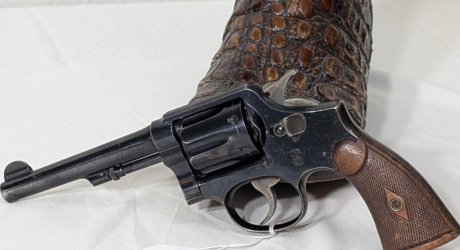
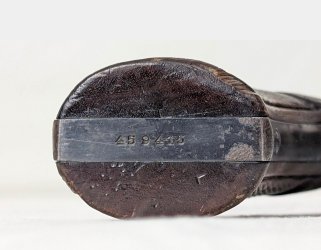
Pre WW2
5" 38 Special
Made in USA
We all know about when and where She was assembled but after that, who knows.
This one might have spent some time in a room or on a shelf with yours Before they parted ways.
SPGUSN just to be clear.
You are not suggesting draw filing will turn a 5" into a 6" are you ?


gnb
Member
DWalt
Member
If anyone remembers the Medusa revolver of the 1990s, it was truly multi caliber and would accept and fire any cartridge nominally of .38 caliber, the entire range between .380 ACP and .357 Magnum, including .38 S&W, .38 Super, and every version and variation of 9mm. No clips needed. I have seen only one example of the Medusa, which I did not fire. Even had the opportunity to buy it, but I declined. Actually, chambering a .38 Special or .357 revolver to .38 S&W (or even better, .38 Super) would not be a bad idea if you wanted multi-caliber versatility. Even without doing that, some makes of .38 Super cartridges will fit and fire just fine in some .38 Special revolvers.
Last edited:
I not only remember them, I was a stocking dealer for a little while when Roger Hunziker brought some samples to my store from his small shop in Huntsville where they were made...They were a hard to sell novelty, but they did function just fine...I did not restock after selling the initial shipment...If anyone remembers the Medusa revolver of the 1990s, it was truly multi caliber and would accept and fire any cartridge nominally of .38 caliber, the entire range between .380 ACP and .357 Magnum, including .38 S&W, .38 Super, and every version and variation of 9mm. No clips needed. I have seen only one example of the Medusa, which I did not fire. Even had the opportunity to buy it, but I declined. Actually, chambering a .38 Special or .357 revolver to .38 S&W (or even better, .38 Super) would not be a bad idea if you wanted multi-caliber versatility. Even without doing that, some makes of .38 Super cartridges will fit and fire just fine in some .38 Special revolvers.
You are correct about the .38 Super chambering and firing in a most .38 Special revolvers since it is a semi-rimmed cartridge...
Similar threads
- Replies
- 24
- Views
- 2K
- Replies
- 9
- Views
- 1K
- Replies
- 15
- Views
- 1K

